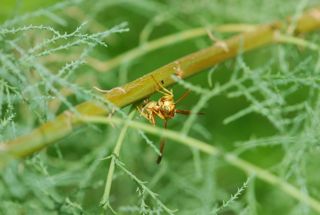Do you have any idea what the hummingbird and the paper wasp from the two previous posts have in common? Answer: both construct interesting and complex nests without the benefit of opposable thumbs. Have you ever wondered how animals make some of their incredible homes? Let’s take a look at some insect architects this week, and possibly get some ideas for our own construction.
1.   Paper Wasps and Hornets

At least 22 species of paper wasps are found in North America and hundreds more species worldwide. They are social insects, which means one female lays the eggs and her daughters help her take care of the resulting offspring.
The paper wasps get their name from the fact they build a nest of a papery material made of thin wood strips and saliva mixed together. Paper wasp nests may be found under eaves or hidden within dense shrubs. Example paper wasp nest
The paper wasps usually construct their nest on a slender stalk and it looks sort of like an upside-down umbrella. The base of the nest contains openings or “cells†where the eggs are laid, and the larvae and pupae are cared for.
Paper wasp inspired activities:
- Paper wasp coloring sheet
- Papermaking with recycled paper
- Construct a paper house. You can fold and decorate a paper house as described here.
- Can paper be used to build actual houses for humans? People are starting to try different paper mixtures. One, called “papercrete,†has already been used to make real houses. Here is a photo of bricks made of paper used to make a house in Phoenix.

- Design and build your own paper house. Be sure to think outside the box, so to speak. Try paper bags, cardboard egg cartons, etc and create new building shapes. I’d love to see what you come up with.
2.   Bumble bees
Bumble bees are large, fuzzy bees that are often yellow and black. They are social, which means they live in groups with a queen that lays the eggs and her daughters that help her, just like the paper wasps.
Bumble bee nests are made of a waxy material, like the wax honeycombs of honey bees, except the cells are oval and are not at all uniform in size or shape. Bumble bees typically nest in the ground, for example in abandoned mouse burrows.
Bumble bee inspired activities:
- Bumble bee coloring sheet
- Building
Design and try to make a building out of soap bars, modeling clay or beeswax, if available. How does this material differ from the paper you used above? Does its softness limit the shapes you can make?
3.   Honey bees
Honey bees make elaborate honeycombs out of a wax they secrete themselves.


Generally honey bees build this comb within an enclosure, such as a hollow tree. Honey bees maintained by people build their comb inside special wooden frames inside a hive box.
Honey bee inspired activities:
Bee Hives and Skeps
Do you know what a skep is? You may have seen these old-fashioned beehives used as decorations. They are coils of straw or dried grass twisted into a dome or bell shape.

Gather some crafting raffia or similar materials. Coil the raffia in a circle to make the base and then fix by sewing or with hotmelt glue. Continue to coil the next layers in increasingly smaller circles until you have created a skep shape. Either paint with bees or craft some bees for decorations.
Geometry:
Why are honey bee cells in the honeycomb in the shape of hexagons? Can you come up with a better shape? Remember that the larvae inside are rounded. Check this link for hints.
http://ag.arizona.edu/pubs/insects/ahb/act18.gif
4.   Ants
Because they often live underground, we might not give as much thought to the nests constructed by ants. Dr. Walter Tschinkel has modified an older technique for looking at the structure of ant nests by pouring dental plaster into the tunnels, allowing it to dry and then digging up the nest, giving a negative-space impression of some truly impressive ant nests.
Dr. Walter Tschinkel’s Ant Castles can be found at the Florida State University. He’s says that the ants can build the huge one at the bottom in just five days!
Ant inspired activities:
- Watch ants build tunnels in a homemade ant farm
- Design and draw plans for an underground home. What would be the advantages of living underground? What might some of the problems be?
Books for more ideas and information:
Roberto, The Insect Architect by Nina Laden
Roberto is an incredibly fun fiction picture book, both for those interested in architecture and those interested in insects.
Nonfiction:
Hornets: Incredible Insect Architects (Insect World) by Sandra Markle
Burrows, Nests & Lairs: Animal Architects by Lark Books (Editor)
Animal Architects by John Nicholson
This award-winning book covers many Australian animals.
Animal Architects – How Insects Build Their Amazing Homes by W. Wright Robinson
Disclosure: I am an affiliate for Amazon. If you click through the linked titles or ads and make a purchase, I will receive a small commission at no extra charge to you. Proceeds will be used to maintain this self-hosted blog.











